Chronic Wasting Disease in MichiganBy Kruger and Dave, August 2010
Camp | Michigan Deer Hunting | Tips and Techniques
| Packing Lists | Recipes
Michigan Deer Hunting History | Deer Camp Photos | Photo Submission | Links | |
What is CWD?
Chronic Wasting Disease (CWD) is a neurologic disease affecting deer, elk, and moose. It causes a deterioration of the brain into a spongy mess. This results in emaciation, erratic behavior, loss of bodily function, and finally death. Deer, elk, and moose spread this disease through saliva, urine, and feces. These infectious materials have been found to live a long time in soil, water, and food sources, making it extremely hard to eradicate. This is why baiting bans have been put into effect in areas where this disease has been found. The only way to tell what in infected is through extensive testing. |
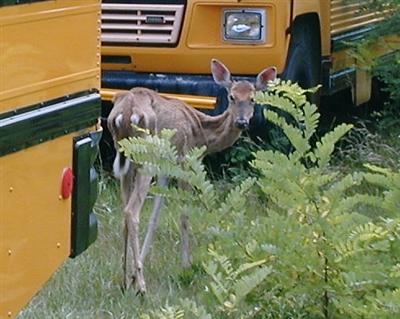
Photo of a Deer with Chronic Wasting Disease
Photo courtsey of Wisconsin DNR and CWD Alliance |
History
CWD was first identified in 1967 in a captive mule deer at the Colorado Division of Wildlife Foothills Wildlife Research Facility in Fort Collins, Colorado. Some research has indicated links to “scrapie”, a similar disease found in sheep, dating back to 1947. Since 2002 the MIDNR has tested some 250 deer in Kent County, with only one positive test. That test was at a Deer Farm on a captive deer. Other cases were thought to have been found in 2005. A number of deer were exhibiting similar behavior to that which a CWD infected deer show. They were shown to have Eastern Equine Encephalitis Virus (EEEV). CWD was long thought to be isolated to wild herds in the area of NE Colorado, SE Wyoming, and SW Nebraska. Lately it has been found in other areas of these states and the following states; South Dakota, Illinois, New Mexico, Utah, Wisconsin, New York, West Virginia, and Kansas. CWD has been found on Deer Farms in the following states; Colorado, Nebraska, Montana, Minnesota, South Dakota, Oklahoma, Wisconsin, Kansas, New York and Michigan. |
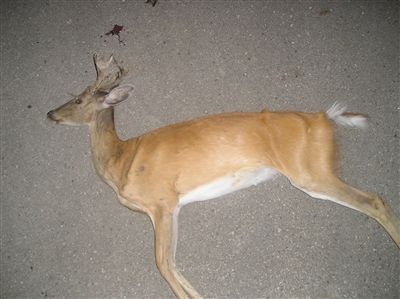
Photo of a Deer With Chronic Wasting Disease
Photo courtsey of Wisconsin DNR and CWD Alliance |
What to look for
Early detection is difficult without lab work. But as the disease progresses you may note a scrawny, malnourished looking deer with a scraggily coat, and a propensity to drool uncontrollably. This is because as the brain deteriorates, the animal eats less and less, and drinks more and more. This leads to a loss in body mass, excessive saliva production, and increased urination. You may also note the animal carrying its head low to the ground, possibly trembling, and its ears drooped over its head. This is because this once majestic creature is now but a shadow if its once glorious self. At this point death is a welcome end to this suffering creature. |
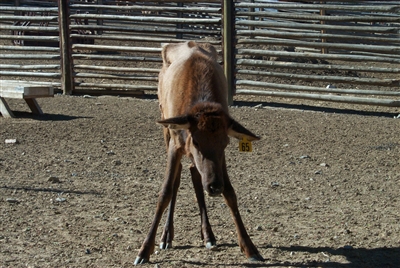
Photo of an Elk with Chronic Wasting Disease
Photo courtsey of Dr. Terry Kreeger, Wyoming Game and Fish Department and CWD Alliance |
Can you get it?
Simple answer, probably not. Research indicates that humans, cattle and other domestic livestock are naturally resistant to the protein that causes CWD. However, there is always the possibility of contracting CWD. As of this writing there have been no documented cases of human contraction of CWD.
As always, the best way to prevent the spread of disease is through prevention. This includes, washing of hands, arms, and any other part that comes into contact with potentially infected materials. Also wash your clothing after you are done hunting. Proper preparation and handling of any, and all meat prior to consumption. Take care, and safe hunting. |
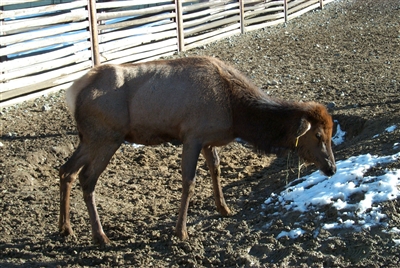
Photo of an Elk with Chronic Wasting Disease
Photo courtsey of Dr. Terry Kreeger, Wyoming Game and Fish Department and CWD Alliance |
Laws to Address CWD
A CWD surveillance zone has been established for the nine townships surrounding the privately owned facility where CWD was detected. The nine townships are Tyrone, Solon, Nelson, Sparta, Algoma, Courtland, Alpine, Plainfield, and Cannon. All deer taken in the surveillance zone must be taken to one of the DNR deer check stations within the CWD surveillance zone. All the deer taken in this zone will be tested for CWD. For deer harvested in this CWD surveillance zone, only boned meat, cape and clean skull plates with antlers may be removed. As of 2009 a total of 32,459 deer, elk, and moose have been tested. Only the one deer in Kent County was found to be CWD positive. For Frequently Asked Questions regarding CWD Click Here (August 2008 DNR Document) |
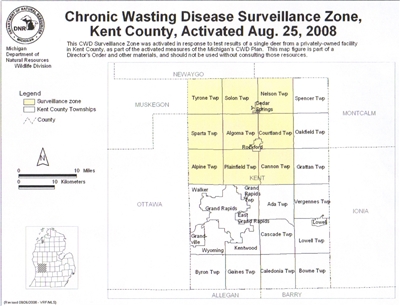
DNR 2008 CWD Surveillance Zone Map.
Click Here for a full size map. |
| The Baiting Ban for the Lower Peninsula has been the most controversial Laws to control the spread of CWD. According to the DNR, "(CWD)...spread among animals that are drawn into close physical proximity by feed. Although the exact means of transmission of chronic wasting disease is not known; most scientists believe any exchange of bodily fluids -- saliva, urine, and feces – facilitates transmission." There are opponents of Baiting Ban that say the DNR is making a big issue out of this disease. Many are wondering why the entire lower peninsula of Michigan was banned from baiting, when only select counties were banned for baiting in the Tuberculosis Zone. Some question that if CWD was not spread to any other animals in a captive herd they how will it spread to the free ranging herd. Some of those who support the ban on baiting believe that the hunter should not rely on bait but put their time in the woods and hunt the deer. Whatever side of the fence you stand on baiting, the law still stands that baiting deer is illegal in the lower peninsula of Michigan. However, that has not stopped a lot of hunters from continuing to bait. Just look at the stores that sell bags or carrots, beats, and apples just prior to firearm deer season.
For Frequently Asked Questions regarding Baiting Click Here (August 2009 DNR Document) |
CWD in Michigan
Michigan has a Mandatory Chronic Wasting Disease Surveillance Laws for captive and free ranging deer herds. The Mandatory Surveillance includes testing of captive animals over 16 months of age that dies and/or is sick. A sample of the animal is sent to a lab for testing. If there are positive animals, then the herd is quarantined until it can be depopulated. This is what happened at J+B Whitetails at 3897 Rector Ave, in Algoma Twp (Kent County just North of Grand Rapids). J+B Whitetails was placed under quarantine as required under the CWD Mandatory Surveillance. Later the 52 remaining deer at J+B Whitetails were destroyed and sent to the lab. All the deer came back negative for CWD. This may have been the end of the story, but every good story needs a scandal and cover-up. Chronic Wasting Disease was no exception. |
The Scandal and Cover-up
After J+B Whitetails were placed under quarantine, Conservation Officers began watching the facility to ensure the quarantine is in effect. Around Midnight on August 23, 2008 (one day after the facility was placed under quarantine) Conservation Officers saw a pickup truck back up to the barn. The officers saw two men go into the deer enclosure with one carrying a long gun and the other a spotlight. After a short period of time, there was a gunshot which the Conservation Officer believed to be a Tranquilizer Gun. The two men left and came back 15 minutes later with a hospital style gurney. The tags from the ear of the deer were removed, and they attempted to put the deer on the gurney but the deer walked away. At 2:20 AM the tranquilizer gun was again fired. The deer laid down and the men loaded it into a trailer. The truck and trailer left the facility at 3:09 AM. The Conservation Officers then stopped the vehicle on Rector Ave.
The two men were James and Brian Schuiteman owners of J+B Whitetails. Conservation Officers interviewed the two. One them said they planned on releasing the deer into the wild. They chose this deer because they thought it was sick. He understood what could have happened if the deer had been released into the wild, but was scared and made a poor decision.
The deer that James and Brian Schuiteman had tranquilized was 14 month old male, spike horn deer. The deer was euthanized and sent to the lab. The deer came back CWD negative. To read the Conservation Officers Report Click Here
James and Brian Schuiteman were charged with "Animal Industry Act-Felony violations did intentionally violate a condition of quarantine authorized under MCL 287.712, by MOVED A DEER AFTER RECEIVING QUARANTINE PROHIBITING MOVEMENT OF DEER; contrary to 287.744(1). Felony penalty up to 5 years and/or $1,000-$50,000." In a plea bargain agreement, James Schuiteman plead guilty to the felony and Brian Schuiteman plead guilty to Animal Industry Act RULE VIOLATION a misdemeanor. James was given a sentence of 180 days in jail and/or early release to tether. Brain was not given any jail time, but given 240 hours of community service. The total fines, costs, and restitution for James and Brain combined was $10,581. To see the court paperwork Click Here
|
Press Release
Press Release:
FOR IMMEDIATE RELEASE March 2, 2009
Contact: Mary Dettloff 517-335-3014
Kent County Private Cervid Facility Charged With Violation of Quarantine
The operators of a private cervid facility located in Kent County's Algoma Township have been charged with violation of the Michigan Department of Agriculture’s (MDA) Chronic Wasting Disease (CWD) Quarantine Order issued in August 2008 after a three-year old Kent County female white-tailed deer tested positive for the disease.
James and Brian Schuiteman, owners of J & B Whitetails, were recently arraigned in 63-1 District Court in Rockford and charged with violating Michigan’s Animal Industry Act for movement of an animal in violation of the quarantine placed on their facility by MDA. This is a felony charge carrying a penalty of $1,000 to $5,000 in fines and imprisonment of up to five years. The Schuitemans waived their right to a preliminary exam in court today.
The charge stems from an incident on Aug. 23, the day after the quarantine was issued by MDA. At approximately midnight, Department of Natural Resources Conservation Officers David Rodgers and Michael Mshar observed two persons enter the quarantined facility with flashlights and a tranquilizer gun. The officers witnessed the subjects seek out a specific deer, tranquilize it, and then remove the deer. The deer was loaded into an enclosed trailer, and towed from the property, where officers conducted a traffic stop to detain the suspects.
Officers determined a live male white-tailed deer was contained in the trailer with identification tags removed. Upon questioning the suspects, the officers learned it was their intent to release the buck into the wild. Officers returned the animal to the facility where it was euthanized and immediately transported to the Diagnostic Center for Population and Animal Health at Michigan State University for testing. The deer tested negative for CWD.
The DNR’s investigation of J & B Whitetails also resulted in the review of records at Big Buck Taxidermy, located adjacent to the enclosure. Investigators determined two free-ranging deer with intact heads were imported into Michigan illegally and delivered to Big Buck Taxidermy by customers. The deer were taken from known CWD-positive areas in Wyoming and South Dakota.
| For more information on the above topic:
www.michigan.gov/emergingdiseases
www.michigan.gov/cwd
www.cwd-info.org
Here is a great video by CWD Alliance. It not only contains information on CWD but how to butcher your deer.
Click Here to view video.
**The above information was gathered from the above websites. |
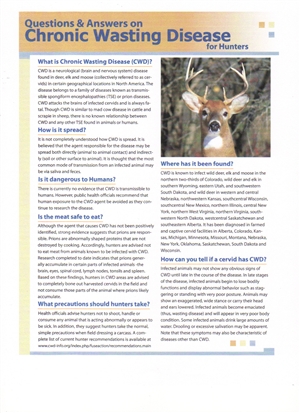
CWD Brochure FAQ from CWD Alliance
Click Here for full size image. |
| Back to Michigan Deer Hunting |
Back to Camp |
|





